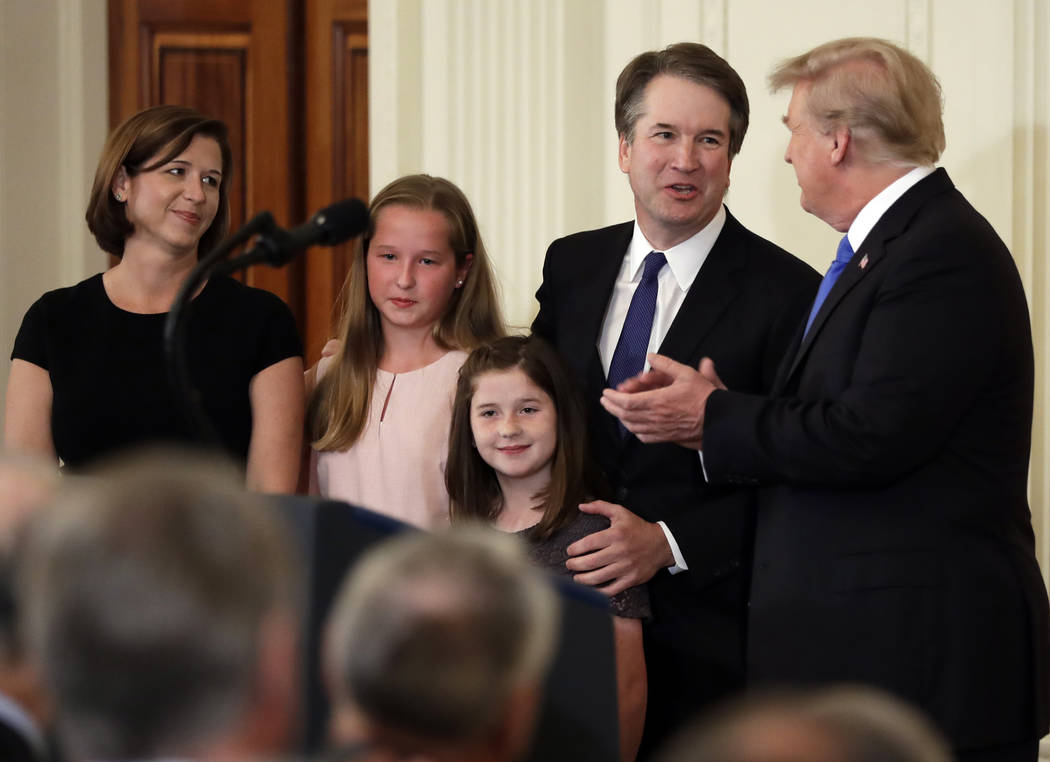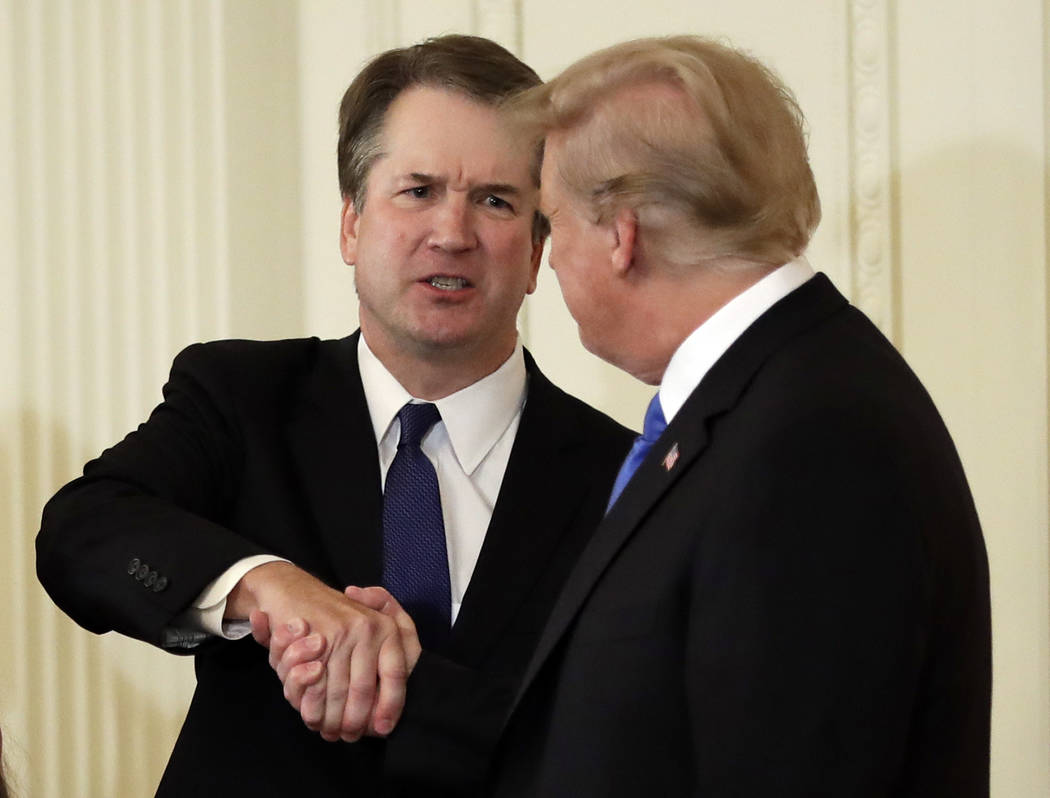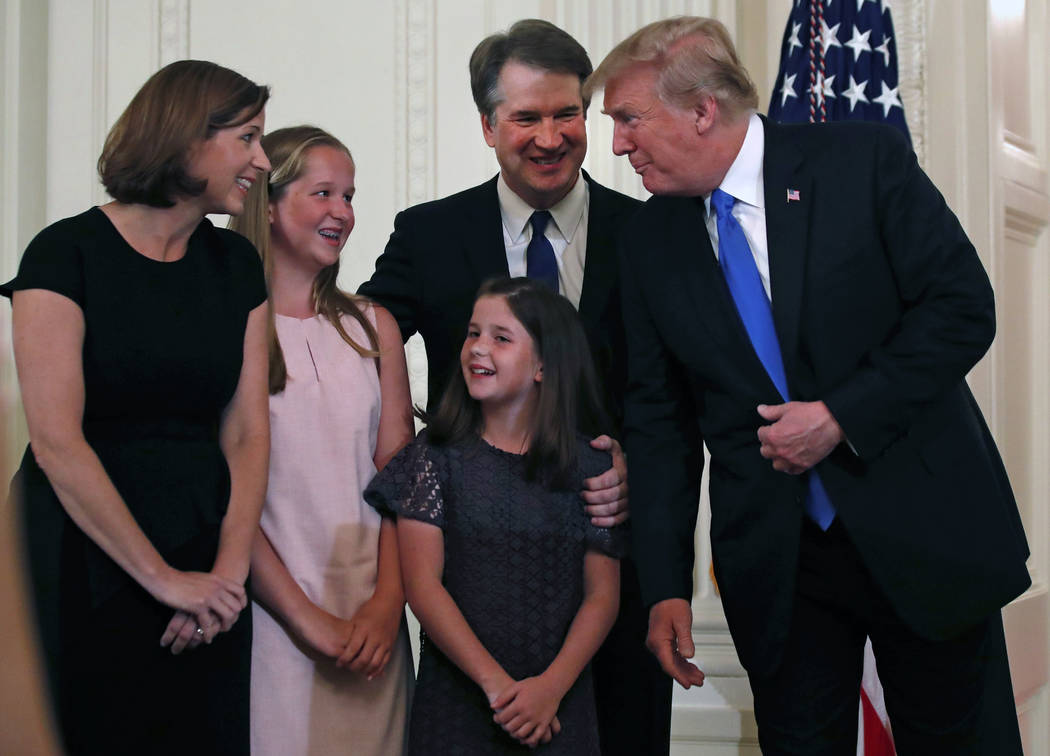Trump picks Kavanaugh to replace Kennedy on Supreme Court




WASHINGTON — A buoyant President Donald Trump named Judge Brett Kavanaugh — “a judge’s judge” —as his choice to succeed retiring Justice Anthony Kennedy on the Supreme Court in a prime-time event in the White House East Room.
Trump chose the same venue he used during his first month in office to announce Neil Gorsuch as his choice to fill the seat vacated by Justice Antonin Scalia after his sudden death in 2016. As occurred last year, Trump managed to keep his nominee’s identity secret in advance of his announcement.
“There is no one in America more qualified for this position and no one more deserving,” said Trump in the televised address, calling Kavanaugh “one of the sharpest legal minds of our time.”
The selection sets up an expected battle for confirmation in the Senate in the months leading up to the November elections.
Even before Trump named Kavanaugh, Democratic opposition had solidified and pro-abortion groups had announced firm opposition since, as a presidential candidate, Trump had declared that he would nominate jurists to the Supreme Court who would overturn the landmark Roe v. Wade decision.
“President Trump has been crystal clear about his litmus tests. He said that any #SCOTUS nominee would oppose gun safety laws and Roe v. Wade would be overturned ‘automatically.’ #WhatsAtStake,” Sen. Dianne Feinstein, D-Calif., tweeted.
Monday night, however, Trump said, “I do not ask about a judge’s personal opinions.”
“My judicial philosophy is straightforward,” Kavanaugh told the crowd. “A judge must be independent and must interpret the law, not make the law. A judge must interpret the Constitution as written.”
Kavanaugh, 53, stood out as the potential nominee with the strongest D.C. establishment credentials on Trump’s short list of candidates.
A graduate of Yale and Yale Law, Kavanaugh clerked for Kennedy. He also worked for independent counsel Ken Starr in the investigation that led to the impeachment of President Bill Clinton. He was partner at Kirkland and Ellis, and he served as staff secretary to President George W. Bush, who released a statement hailing Kavanaugh as “a brilliant jurist.”
In an emotional moment, Kavanaugh recalled his first date with his wife Ashley, who also worked in the Bush White House, on Sept. 10, 2001. The next day he was a few steps behind her when Secret Service ordered them to flee the White House as a plane was incoming.
Since 2006, Kavanaugh has served as a judge on the U.S. Court of Appeals for the District of Columbia, where he has written as many as 286 opinions, according to Adam Feldman of the blog Empirical SCOTUS. Feldman likened Kavanaugh to Trump’s first pick for the Supreme Court, Neil Gorsuch, as both possess strong qualifications and rule conservatively but are “not particularly divisive.”
Detractors warn that Kavanaugh has written so many opinions over the years that Democrats could drag out his nomination and thus doom GOP hopes to have a new justice installed before the Supreme Court convenes on the first Monday of October.
Last week, the White House had leaked the names of Kavanaugh, Amy Coney Barrett and Raymond Kethledge as the short-list trio likely to be picked to replace Kennedy, who was a swing vote on many divisive social issues.
But as the week neared an end, a new name was added to the mix, Thomas Hardiman. White House sources teased reporters on Friday with his assertion he would pick his choice at noon on Monday, hours before his announcement. Monday afternoon cable news networks announced Trump had made up his mind.
Trump drew his finalists from a list of 25 potential Supreme Court justices compiled with the help of the conservative Federalist Society and Heritage Foundation. It began as a list of 11 possible nominees in May 2016 that presidential candidate Trump used to reassure Republican voters that he would choose reliably conservative candidates with impeccable credentials. Trump later added names to the list twice.
Trump has considered the list key to his election victory.
For that very reason, Senate Minority Leader Chuck Schumer signaled on the Senate floor Monday that he likely would oppose anyone Trump nominated.
“The president has gone to two far out-of-the-mainstream, hard-right groups – the Heritage Foundation and the Federal Society – and asked them, not the Senate, to advise and consent on a Supreme Court nomination,” Schumer said.
With 51 Republicans, including Sen. John McCain of Arizona who has been ill, in the Senate, the Trump White House will have to work hard to push through Kavanaugh’s confirmation.
Trump’s first task will be to keep GOP Sens. Susan Collins of Maine and Lisa Murkowski of Alaska from defecting, as interest groups like the ACLU have launched ad campaigns to reject any nominee who might overturn Roe v. Wade.
The day after Kennedy announced he would retire, Trump invited Senate Judiciary Committee Chairman Chuck Grassley, R-Iowa, plus Collins and Murkowski to the White House to discuss the vacancy. Also in attendance were Sens. Joe Manchin, D-W.V., Joe Donnelly, D-Ind., and Heidi Heitkamp, D-N.D., three Democrats who voted to confirm Gorsuch.
All three Democrats are from states Trump won handily in November 2016, and all three face tough re-election fights this year.
None of the three Democrats showed up to Monday night’s announcement.
Collins and Murkowski also skipped the event, as did Sen. Rand Paul, R-Ky.
According to The Hill, Paul takes issue with a 2011 decision Kavanaugh wrote that upheld the individual mandate in President Barack Obama’s Affordable Care Act. Paul issued a statement in which he said he would keep an “open mind” about Kavanaugh.
The Center for American Progress announced a rally in front of the Supreme Court building to protest Trump’s pick ahead of the announcement. After Trump’s announcement, the group’s CEO, Neera Tanden, called the nomination “an offensive choice.”
Contact Debra J. Saunders at dsaunders@reviewjournal.com or at 202-662-7391. Follow @DebraJSaunders on Twitter.














